This second annual Workforce Trends Report underscores the power of culture as a driver of engagement and adaptability. Organizations that support flexibility, invest in learning and development, and lead with authenticity are better positioned to overcome today’s challenges and shape a brighter future for employees.
A letter from DHR Global CEO Priya Taneja
As we look ahead to 2026, business leaders around the world are navigating a shared set of challenges: employee engagement is declining, burnout is rising, and the pace of change—driven by economic uncertainty, AI advancements, and evolving work models—continues to accelerate.
To help you meet this moment, I’m proud to share DHR Global’s second annual Workforce Trends Report. We surveyed 1,500 corporate professionals across North America, Europe, and Asia to understand how these forces are reshaping the workplace, and to identify actionable strategies for sustaining engagement and retention. These are the same questions we ask ourselves as we grow globally while staying true to our people-first values.
While regional nuances exist, the findings reveal a universal truth: Culture is a powerful driver of engagement and adaptability. Organizations that prioritize flexibility, invest in development, and lead with authenticity are better equipped to navigate today’s complexity and build a more resilient future.
Inside this report, you’ll find data-driven insights and practical guidance to help you lead with intention—fostering trust, transparency, and connection across your teams.
At DHR Global, we bring a unique perspective as a global boutique firm with deep expertise in the middle market. We hope this report sparks meaningful conversations within your organization and helps you shape a workplace where people and performance thrive.
Leading the Way in 2026
From what drives employee engagement and burnout to the impact of AI, get the information executives need to pave a path for success in 2026.
The identity crisis: Workplace culture faces a new test
Culture is the bedrock of every organization. Nearly all respondents say their workplace culture is somewhat (40%) or very (53%) important to their employee experience. But only 36% of workers feel their company culture is well-defined and drives performance, with many instead describing it as reactive and inconsistent across teams (46%) or vague and not actively shaped (15%).
Long gone are the days when most employees worked together in offices, where shared routines and spontaneous conversations shaped culture naturally. Now, employees in more distributed work environments value meaningful recognition and autonomy over office perks or social events.

The culture disconnect: A two-way street
While 77% of C-suite leaders say culture is “very important,” only 37% of entry-level employees feel the same. Executives are also 2.5x more likely than entry-level staff to view their company’s culture as well-defined. Leaders may set the vision, but culture only thrives when employees buy in and actively participate. Even the most strategic cultural initiatives fall flat without that connection.
Top ways employers can enhance work experience for employees

Recognition and flexibility top the list of what employees say would most improve workplace culture today. This emphasis on recognition also shows up in burnout data: the share of employees citing lack of reward or recognition as a top burnout driver nearly doubled since last year, from 17% to 32%.
The call for a more effective workplace culture runs deep. Nearly one-third of respondents (31%) chose “a stronger, more purposeful workplace culture” as one of the Top 3 improvements they want from their employer over the next year.
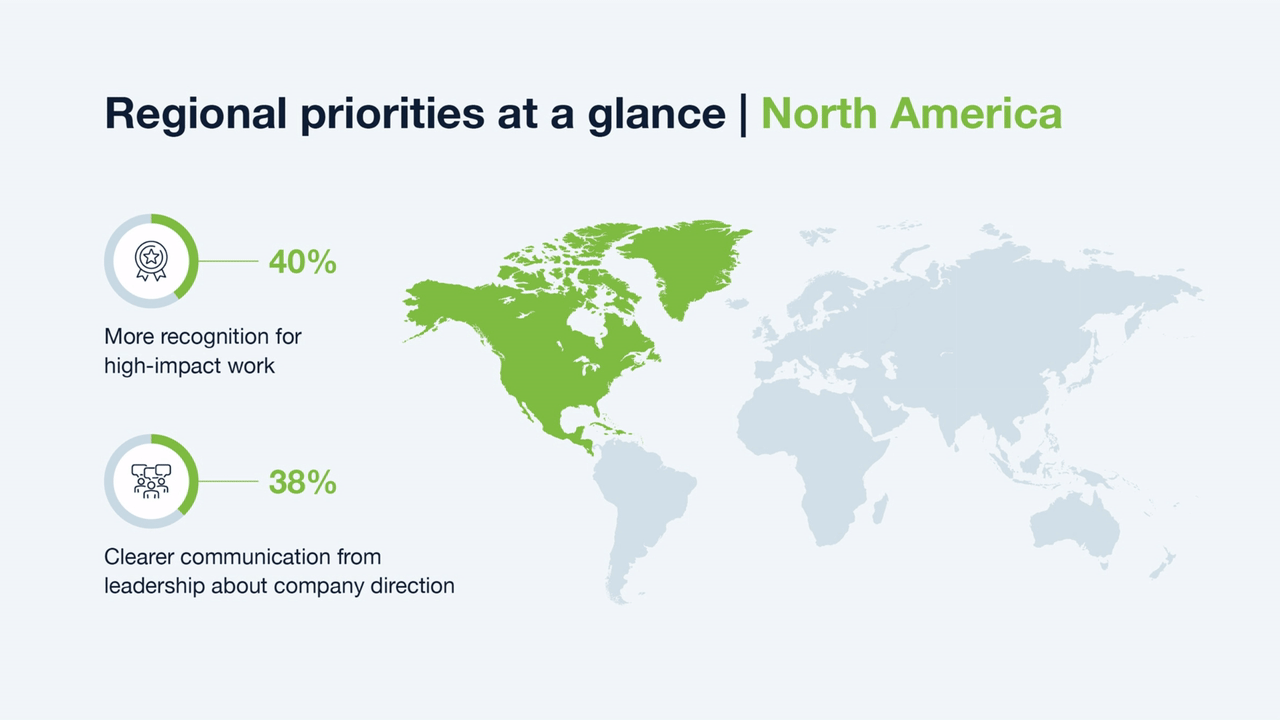
Key Takeaway
With culture no longer anchored by office routines, leaders must work to make it tangible for employees through visible recognition, real flexibility, and values practiced daily. Lasting and scalable company culture also requires active, meaningful employee participation.
Leaders can nurture workplace culture by building recognition programs that reach every level, tailoring flexibility to the needs of different teams and regions, and modeling the culture they want to see. Leaders can also make culture a shared responsibility by inviting input and contributions from employees.
Engagement falls, burnout persists: The new retention risk
Employee engagement has dropped significantly year-over-year, with just 64% of workers describing themselves as very or extremely engaged — down from 88% in 2025. This trend is consistent across regions, with engagement lowest in Asia (59%), and slightly higher in North America (67%) and Europe (68%).
Professional development continues to be the top driver of engagement (71%), ahead of remote/hybrid work (63%) and GenAI tools (55%).
Yet, as flexible work and AI become standard realities, their positive impact on engagement is fading. Many employees are feeling the strain as the novelty of flexible work and AI diminishes and job security grows less certain more broadly.
Drivers and hindrances to employee engagement, 2025 vs. 2026
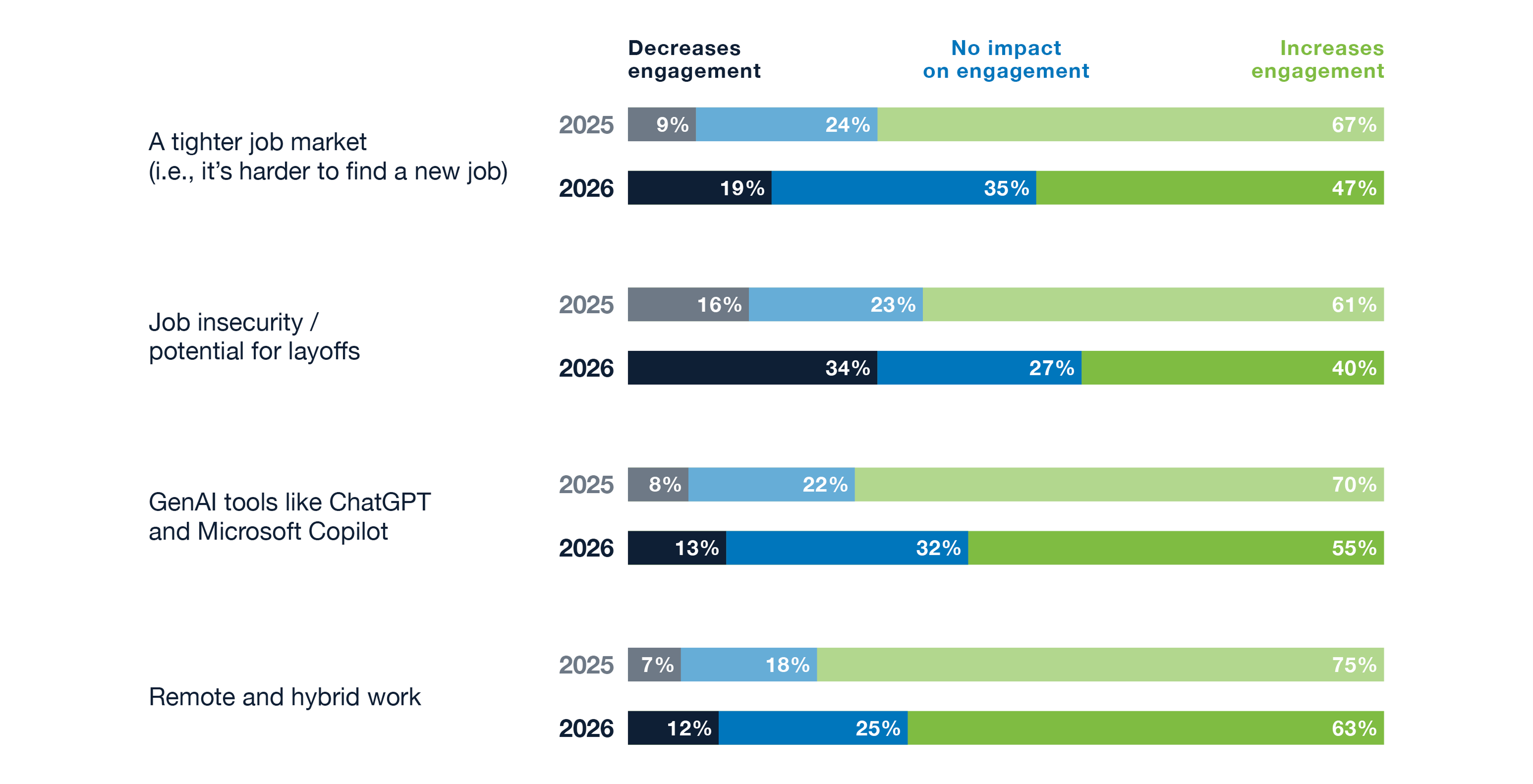
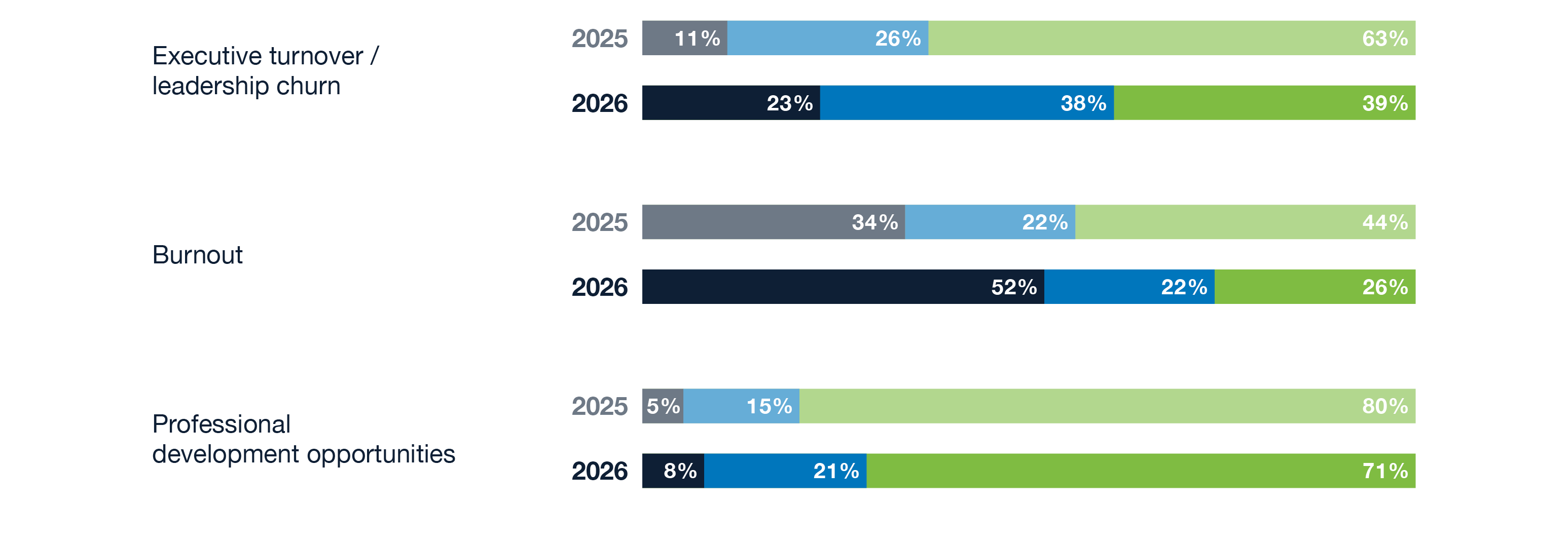
As engagement declines, burnout remains a major challenge among employees, with 83% of workers feeling at least some degree of burnout, consistent with 2025 (82%).
The issue is most pronounced in the retail (62%), tech (58%), and healthcare (61%) industries, where moderate to extreme burnout is highest. Overwhelming workloads (48%) and working too many hours (40%) top the list of causes for respondents across all regions.
Top burnout drivers 2025 vs. 2026
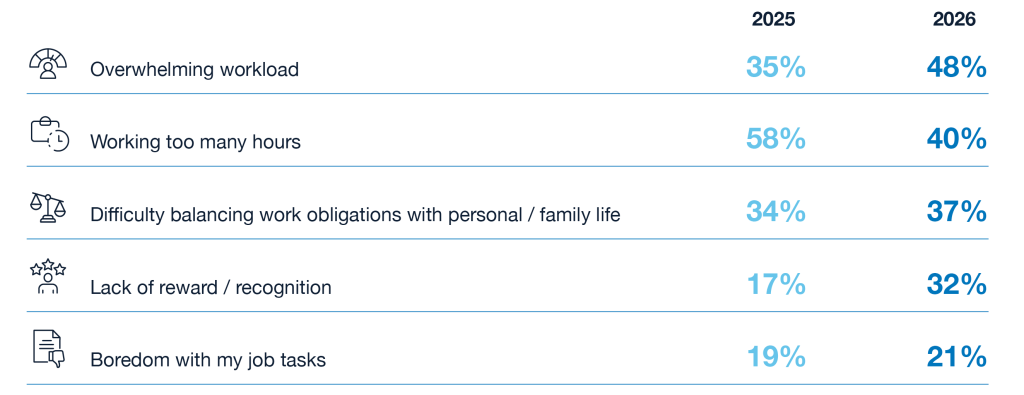
What’s fueling persistent burnout?
It’s worth noting that while burnout rates are holding steady, burnout’s influence on engagement has grown: 52% of workers say burnout drags down engagement, up from 34% in 2025.

Does tech culture drive engagement
Despite higher levels of burnout among workers, tech leads all sectors in engagement, with 78% of employees reporting they’re very or extremely engaged. Nearly half of tech workers (48%) say their workplace culture is well-defined and actively shapes their experience, suggesting that a strong company culture may be helping sustain the industry’s above-average engagement rate.
Burnout also hits some employee groups harder than others. Associates (62%) and entry-level employees (61%) are the most likely to report reduced engagement due to burnout, compared to just 38% of C-suite leaders, 55% of VPs, 44% of directors, and 48% of managers.
Failing to address burnout head-on risks not only eroding employee morale and productivity, but also losing key talent. The turnover of high-performing employees creates additional hurdles for organizations, with 91% of respondents saying that the loss of high-performing colleagues impacts the organization.
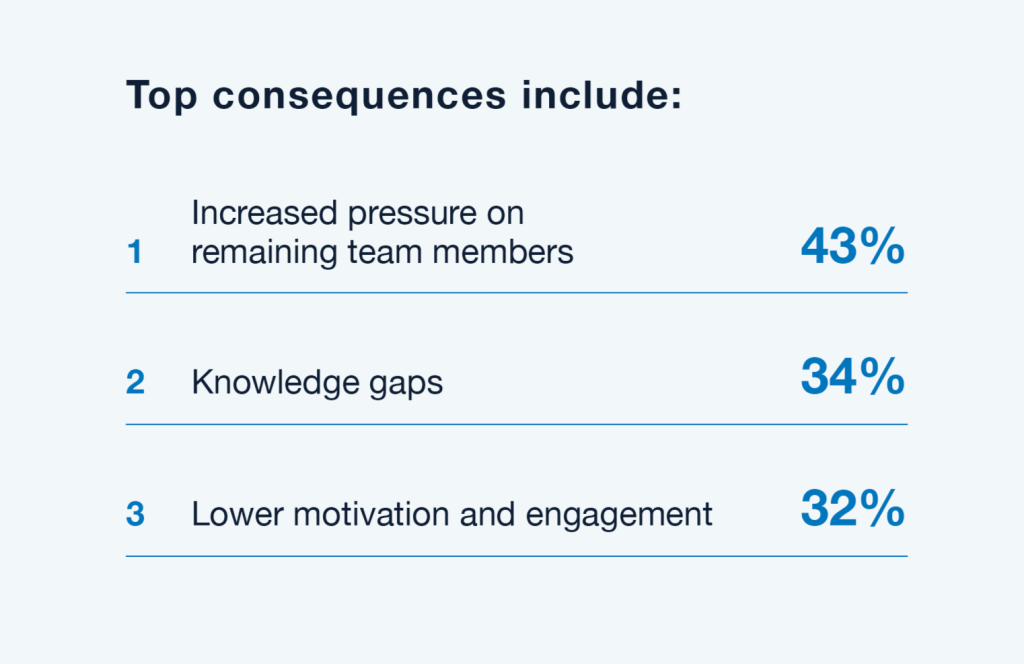
Key Takeaway
Declining engagement and persistent burnout call for decisive action. The focus should be on building strong workplace connections and communication so every employee feels valued and motivated.
Leaders must prioritize managing workloads and hours to address top burnout drivers, and invest in professional development to boost retention. It’s particularly important to pay close attention to early-career employees, who are especially vulnerable to disengagement.
AI’s double-edged sword: Productivity gains and communication gaps
AI has quickly become a fixture in the modern workplace. Over the past year, 39% of employees reported noticeable productivity gains from AI tools, with the highest impact in Asia (44%), followed by Europe (40%) and North America (33%).
Organizations are responding by adjusting learning and development priorities (34%), shifting more responsibilities to strategy and critical thinking (27%), and creating new roles to oversee AI systems (25%).
AI’s impact on organizations over the past 12 months

Despite AI’s growing influence, most employees are still waiting for guidance on what the technology means for their daily roles and skills. Only 34% say their organization has already communicated this information “very clearly.”
Employee appetite for leadership direction is strong, with 24% of workers ranking a clear plan for how AI will affect their job among the Top 3 changes they want this year.
Without this guidance, employees have had to decide on their own which skills feel valuable for career growth in the age of AI. Most are prioritizing deep expertise in a specific area (35%), while others are focusing on broader cross-functional knowledge (29%), soft skills like communication and leadership (22%), or AI and data literacy (13%).
Clear communication around AI adoption makes all the difference. Case in point, tech. Half of employees (52%) working in tech say their company has been very clear about AI’s impact, the highest of any sector surveyed. Tech employees are also most likely to report a significant engagement boost from GenAI tools (37%, versus 14-23% in other sectors), signaling a clear line between AI strategy and benefits.
The AI leadership gap
While 69% of C-suite leaders and 51% of VPs say their organization has communicated very clearly about AI, only 12% of entry-level staff and 22% of associates agree. The divide shows up in engagement, too: 74% of C-suite leaders report higher engagement because of GenAI, compared to just 27% of entry-level employees. Leaders may believe they’re communicating clearly, but most employees aren’t hearing it, putting successful AI adoption and engagement at risk.
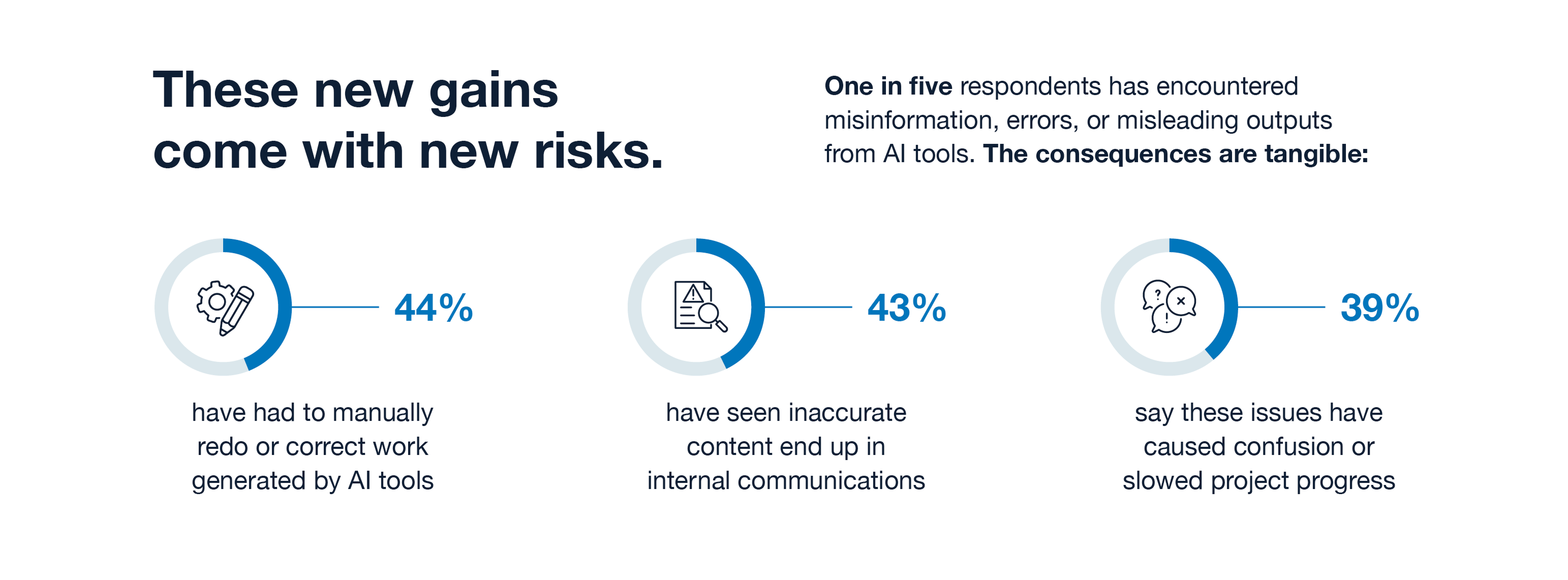
Key Takeaway
AI is rapidly transforming work, but most employees still lack guidance on how the technology will affect their roles and skills, particularly early-career employees. The answer lies in proactive and clear communication.
To realize the full value of AI, leaders should focus on transparent, consistent messaging and give employees at every level a prescriptive roadmap for adapting and growing alongside new technology.
RTO reality: Flexibility is key to earning employee buy-in
Return-to-office (RTO) policies are still reshaping the workplace, but employee buy-in is far from guaranteed. Over the past two years, 38% of employees have been directly impacted by RTO mandates, yet only 34% fully support their organization’s approach. Nearly a quarter (23%) somewhat or strongly oppose it.
Regional responses to RTO vary: 47% of employees in Asia have been directly impacted by RTO, compared to 34% in Europe and 32% in North America. Still, strong opposition is highest in North America (18%) and much lower in Europe (7%) and Asia (3%), signaling that American employees may have more extreme expectations for work flexibility.
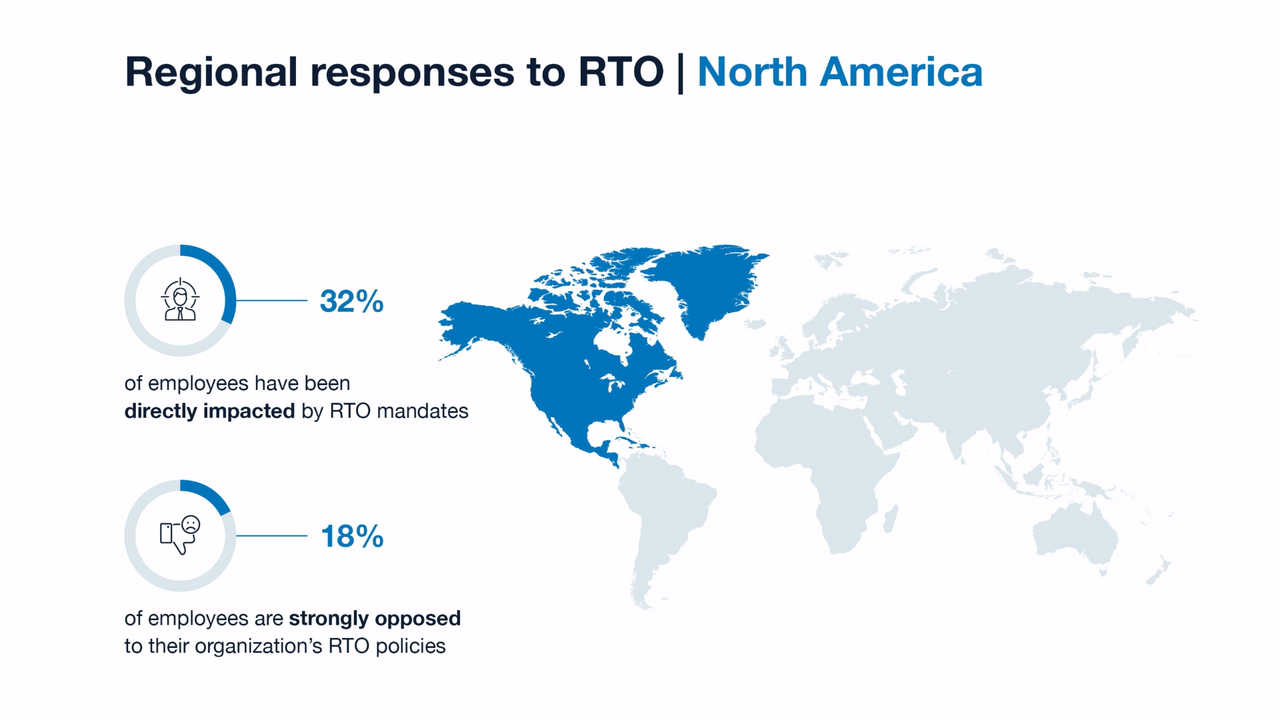
RTO support is also
divided by level.
While 61% of C-suite leaders are in full support, that figure drops to less than 40% among other roles — including just 30% of entry-level staff and 19% of associates. Younger generations with little experience of pre-pandemic office life may be even less likely to see the benefits of in-person work.
Underlying this resistance is a desire for clarity and choice. Employees want a say in their in-office experience, with the option to choose which days to come in as their top request.
Understandably, employees want to know the “why” behind in-person work mandates. When organizations don’t communicate that, RTO policies can feel arbitrary and quickly lose support.
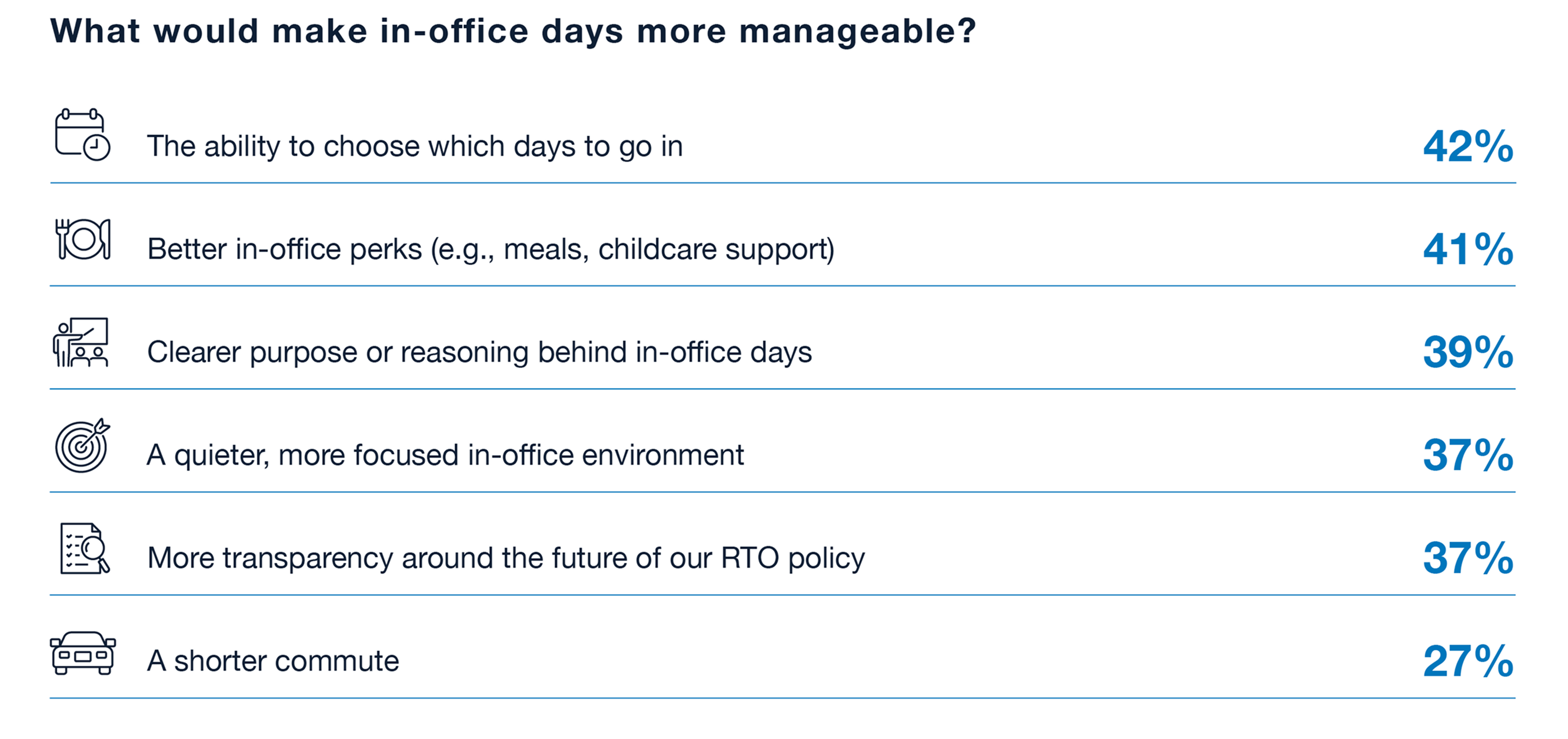
Key Takeaway
RTO decisions are a test of trust and understanding across regions. In North America, opposition is much higher than in Europe or Asia, reflecting different expectations for flexibility and communication globally.
But regardless of location, earning buy-in demands clear explanations of the reasons behind in-person work and involvement from employees in shaping how RTO functions. When you connect policies to local realities and elevate employee voices, support and engagement naturally follow.
Building organizational resilience for what’s next
Investing in professional development ensures employees are prepared for the future, both technologically and professionally. When RTO policies are implemented with clarity and care, employees are more likely to stay connected and committed. And by prioritizing culture and skill-building, leaders will create the conditions for agility, resilience, and long-term business success.
At a time when so much is uncertain, leadership grounded in trust, continuous learning, and authentic connection is what really moves organizations forward.
Leading the Way in 2026
From what drives employee engagement and burnout to the impact of AI, get the information executives need to pave a path for success in 2026.
Methodology
DHR Global surveyed 1,500 white-collar, desk-based knowledge workers who are proficient in English and aged 21 or older. Respondents were evenly distributed across three geographic regions: 500 from North America (U.S. and Canada), 500 from Europe (Germany and the U.K.), and 500 from Asia (India, Hong Kong, and Singapore).
*Percentages do not add up to 100% due to rounding.
DHR Global
Always Connected.
DHR is a leading, privately held provider of executive search, leadership consulting, and emerging leader search services, operating in 60+ markets across 22 countries. With deep expertise across more than 20 industries and functions, DHR delivers talent solutions through consultants with firsthand industry experience. For over 35 years, the firm has been known for being connected, accountable, and client-focused, and ready to deliver the right talent, fast.
